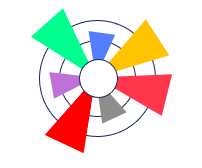What is the KM plotter?
The Kaplan Meier plotter is capable of assessing the correlation between the expression of all genes (mRNA, miRNA, protein, & DNA) and survival in 40k+ samples from 21 tumor types. The clinical subsystem includes 3.55 million patients. Applied statistical tools include Cox proportional hazards regression and the computation of the False Discovery Rate. With 20,000 analyses per day, the KM-plotter is a worldwide reference for the discovery and validation of survival biomarkers.
--------------------------------------------------------------------------------------------------------------------------Use the genes in following tools to:
--------------------------------------------------------------------------------------------------------------------------
Please kindly cite our latest papers to support further development:
Gyorffy B: Integrated Analysis of Public Datasets for the Discovery and Validation of Survival-Associated Genes in Solid Tumors, The Innovation, 2024, https://pubmed.ncbi.nlm.nih.gov/38706955/.
Gyorffy B: Transcriptome-level discovery of survival-associated biomarkers and therapy targets in non-small-cell lung cancer, British Journal of Pharmacology, 2024, https://pubmed.ncbi.nlm.nih.gov/37783508/.
--------------------------------------------------------------------------------------------------------------------------How does it work?
KM-plotter is the most sophisticated online survival analysis tool, performing all calculations in real time (not loading pre-calculated images). The background database is manually curated. Gene expression data and relapse free and overall survival information are downloaded from GEO, EGA and TCGA. The database is handled by a PostgreSQL server, which integrates gene expression and clinical data simultaneously. To analyze the prognostic value of a particular gene, the patient samples are split into two groups according to various quantile expressions of the proposed biomarker. The two patient cohorts are compared by a Kaplan-Meier survival plot, and the hazard ratio with 95% confidence intervals and logrank P value are calculated. Databases and clinical data are supervised and extended regularly.
What is the best cutoff?
To avoid missing correlations due to the use of a specific cutoff, all available cutoff values between the lower and upper quartiles of expression are used for the selected gene, and false discovery rate (FDR) using the Benjamini-Hochberg method is computed to correct for multiple hypothesis testing. The cutoff value with the highest significance (lowest FDR) is determined. In case of multiple cutoff values with identical significance, the cutoff with the highest hazard (HR) rate is selected for the final analysis.
Which gene ID can I use?
KM-plot recognizes 70,632 gene symbols (including HUGO Gene Nomenclature Committee approved official gene symbols, previous symbols and aliases - all these are listed in the results page). As the different names can overlap, we recommend to cross-check the identity of the selected gene.
Where do you have the data from?
Sources for the database include GEO, EGA, TCGA, Metabric, Impact, and PubMed repositories. For more details, please check our publications.
I have selected gene XXX but the results are for gene YYY - why is this?!
The genes symbols are not unambiguous and the HUGO database we use for the selection of the probe sets also includes overlapping gene symbols. Please read following example to understand the phenomena: let's assume we want to measure EPHA3. Once we start typing EPHA3, the system suggests a probe set: 206070_s_at. Now, in case the all probe sets per gene is enabled, the system looks up all gene symbols for 206070_s_at. These are EPHA3, ETK1, HEK4, TYRO4, ETK, and HEK. As all probe sets should be included, the system looks up all 21 probe sets linked to any of these symbols. Finally, at the end, all gene symbols are listed on the results page.
I have several candidates. How can I select the reliable ones?
You need to correct for multiple testing. For this, we suggest to use our multiple testing calculator.
Can I have a better image?
There are four options: 1) utilize the scalable PDF provided at the results; 2) adjust "Settings" to generate a hi-res TIFF file; 3) use our powerpoint template to change font and the text size; 4) still not satisfied?! -> adjust "Settings" to export plot data as text and format it in any other software.
Can I use multiple genes?
Yes. Click on the button "Use multiple genes" and enter multiple genes. You can run the analysis on all these biomarkers simultaneously (default setting), or using the mean expression of the genes, or using the ratio of two genes, or using the expression of one gene as a filter.
Can I check response to chemotherapy?
To validate predictive biomarkers, we suggest the ROC plotter, available at the ROCplot website.
Are microarrays and RNA-seq datasets combined?
No way! In one analysis, one platform is included only, because this enables to measure the same gene with the same sensitivity, specificity, and dynamic range.
Can I link gene expression and mutation status?
To link mutation or CNV data to gene expression and survival, try our online platform Genotype 2 Outcome, available at the G-2-O website.
Want to predict survival for a single patient?
Try Recurrence Online, a tool capable to predict response to hormonal treatment, to targeted therapy and survival (recurrence score) for breast cancer patients using gene expression data obtained by Affymetrix gene chips.
--------------------------------------------------------------------------------------------------------------------------What can the KM plotter do?
------------------------------------------------------------------------------------------------------------------------
The KM-plotter has been utilized among others in studies published in:

------------------------------------------------------------------------------------------------------------------------
We thank those users who provide feedback and reassure the development of the KM-plotter:
"Thank you for publishing your outstanding Kaplan-Meier Tool. This has provided us and many other researchers opportunities to search the importance of our genes with outcome." - Clodia Osipo, Loyola University, Chicago, IL, USA
"I'd like to thank you for your precious tool. It's really fantastic! Great job!" - Loris De Cecco, Functional Genomics and Bioinformatics Unit, Fondazione IRCCS Istituto Nazionale dei Tumori, Milan, Italy
"KM-plotter is a very good and user friendly online database, and it became very popular website at here, Breakthrough Breast Cancer Research Centre of ICR." - Alice Gao, ICR, London, UK
"We are indebted to you for this beautiful thing you have done in the form of KM-plot. It makes life so much easier to look at a survival plot even before you design your experiments - simply great." - Debasish Boral, SIU School of Medicine, Springfield, IL, USA
"First of all, I would like to thank you and your team for offering such a wonderful tool!" - Divya Sudhan, University of Florida College of Medicine, USA
"Your webpage is a great tool, it has been great help in my projects. Wonderful work!" - Sait Ozturk, Boston University, Boston, MA, USA
"Again you made a useful tool for the community." - Stanislas du Manoir, INSERM, Montpellier, France
"Thank you to the group for this valuable tool." - John A. Martignetti, Icahn School of Medicine at Mount Sinai, New York, NY, USA
"The online KM plotter software is fantastic." - Reuben Harwood, Dept. Oncology, University of Sheffield, Sheffield, UK
"Thanks for the amazing tool!" - Aldema Shoshana Chen, Weizmann Institute of Science, Rehovot, Israel
"Thank you for the KM-plotter." - Chris Oh, University of Queensland, Australia
"Congratulations and thank you for developing KM-plot, it is a very helpful tool!" - Gerwin Heller, Medical University of Vienna, Vienna, Austria
"I would like first to thank you very much for making such an easy to use, rich in information online tool available to the community!" - Ioannis Zervantonakis, Harvard Medical School, Boston, MA, USA
"I love the new function to upload genes!" - Anne Grosse-Wilde, Institute for Systems Biology, Seattle, WA, USA
"I have been utilizing the KMplot tool and have found it to be very useful. Thank you for your work in creating this resource!" - Ed O'Donnell, Cancer biology laboratory, Oregon State University, Corvallis, OR, USA
"I love your KM plotter program" - Deborah J Marsh, Functional Genomics Laboratory, University of Sydney, Australia
"It is an amazing tool." - Shih-Chieh Lin, Baylor College of Medicine, Houston, TX, USA
"We recently started using your KM plotter tool at DKFZ in Heidelberg and are highly delighted about the features and wealth of information the software provides." - Verena Thewes, Division Molecular Genetics, German Cancer Research Center, Heidelberg, Germany
"My collaborators are enthusiastic users of your KM plot website, they have used it to generate hypothesis and are on to test them." - Caterina Vacchi-Suzzi, Stony Brook, NY, USA
"Thank you for the KM-plotter." - Ling-Yueh Hu, Institute of BioMedical Sciences, Academia Sinica, Taipei, Taiwan



